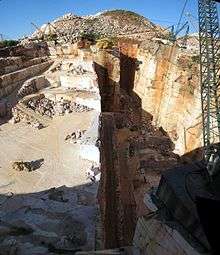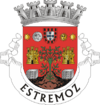Estremoz
| Estremoz | |||
|---|---|---|---|
| Municipality | |||
 | |||
| |||
 | |||
| Coordinates: 38°51′N 7°35′W / 38.850°N 7.583°WCoordinates: 38°51′N 7°35′W / 38.850°N 7.583°W | |||
| Country |
| ||
| Region | Alentejo | ||
| Subregion | Alentejo Central | ||
| Intermunic. comm. | Alentejo Central | ||
| District | Évora | ||
| Parishes | 9 | ||
| Government | |||
| • President | Luis Filipe Pereira Mourinha (Ind.) | ||
| Area | |||
| • Total | 513.80 km2 (198.38 sq mi) | ||
| Population (2011) | |||
| • Total | 14,318 | ||
| • Density | 28/km2 (72/sq mi) | ||
| Time zone | WET/WEST (UTC+0/+1) | ||
| Website | http://www.cm-estremoz.pt | ||
Estremoz (Portuguese pronunciation: [(ɨ)ʃtɾɨˈmoʃ]) is a municipality in Portugal. The population in 2011 was 14,318,[1] in an area of 513.80 km².[2] The city Estremoz itself had a population of 7,682 in 2001.[3] It is located in the Alentejo region.

History
The region around Estremoz has been inhabited since pre-historic times. There are also vestiges of Roman, Visigoth and Muslim occupation.
During the Reconquista, Estremoz was captured in the 12th century by the army of knight Geraldo Sem Pavor (Gerald the Fearless), who had also conquered neighbouring Évora. However, Estremoz was soon retaken by the Moors and only in the mid-13th century was it reconquered by the Portuguese King Sancho II.
An important strategic site between the Kingdoms of Portugal and Castile, Estramoz received a charter (fuero) in 1258 from Afonso III after the Moors were driven out a second time, which promoted Christian colonization in the area. King Dinis rebuilt the castle as a royal palace, further promoting the area. His widow, Dowager Queen Elizabeth of Portugal, died in Estremoz castle on July 4, 1336, shortly after mediating a peace treaty between her son Alfonso IV of Portugal and grandson Alfonso XI of Castile. Her grandson Pedro I of Portugal died in the Franciscan monastery at Estremoz in 1367. During the 1383–1385 Crisis, Nuno Álvares Pereira established his headquarters in Estremoz, then defeated the Castilian forces at the Battle of Atoleiros.
During the Portuguese Restoration War (1640–1668), Portuguese forces (including from Estremoz) defeated the Castilians in the nearby and decisive Battles of Ameixial (1663) and Montes Claros (1665).
Marble
Together with the two other marble towns, Borba and Vila Viçosa, Estremoz is internationally known for its fine to medium marble that occurs in several colours: white, cream, pink, grey or black and streaks with any combination of these colours. Especially the pink marble (Rosa Aurora and Estremoz Pink) is in high demand.[4]
This marble has been used since Antiquity as a material for sculpture and architecture. The first exports in Roman times were probably for the construction of the Circus Maximus of Emerita Augusta, in modern day Spain. The Portuguese navigators exported this marble to Africa, India and Brazil. The marble from this region was used in famed locations such as the Monastery of Jerónimos, the Monastery of Batalha, the Monastery of Alcobaça and the Tower of Belém.
There is so much marble around Estremoz that it is used everywhere; even the doorsteps, pavements and the cobble stones are made out of marble. This marble is even converted into whitewash for painting the houses.
Portugal is the second largest exporter of marble in the world, surpassed only by Italy (Carrara marble). About 85% of this marble (over 370,000 tons) is produced around Estremoz.
In the quarries marble blocks are cut from the rock with a diamond wire saw, a durable steel cable with a series of circular diamond beads. The initial conduit for the wire is made by drilling a horizontal hole and a vertical hole of which the ends meet exactly inside the rock. The wire saw may need a day to cut through the marble.
Parishes
Administratively, the municipality is divided into 9 civil parishes (freguesias):[5]
- Ameixial (Santa Vitória e São Bento)
- Arcos
- Estremoz (Santa Maria e Santo André)
- Évora Monte (Santa Maria)
- Glória
- São Bento do Cortiço e Santo Estêvão
- São Domingos de Ana Loura
- São Lourenço de Mamporcão e São Bento de Ana Loura
- Veiros
References
- ↑ Instituto Nacional de Estatística
- ↑ Direção-Geral do Território
- ↑ UMA POPULAÇÃO QUE SE URBANIZA, Uma avaliação recente - Cidades, 2004 Archived October 6, 2014, at the Wayback Machine. Nuno Pires Soares, Instituto Geográfico Português (Geographic Institute of Portugal)
- ↑ Marble in Portugal
- ↑ Diário da República. "Law nr. 11-A/2013, pages 552 45-46" (pdf) (in Portuguese). Retrieved 22 July 2014.
External links
 Media related to Estremoz at Wikimedia Commons
Media related to Estremoz at Wikimedia Commons- website
- Photos from Estremoz


